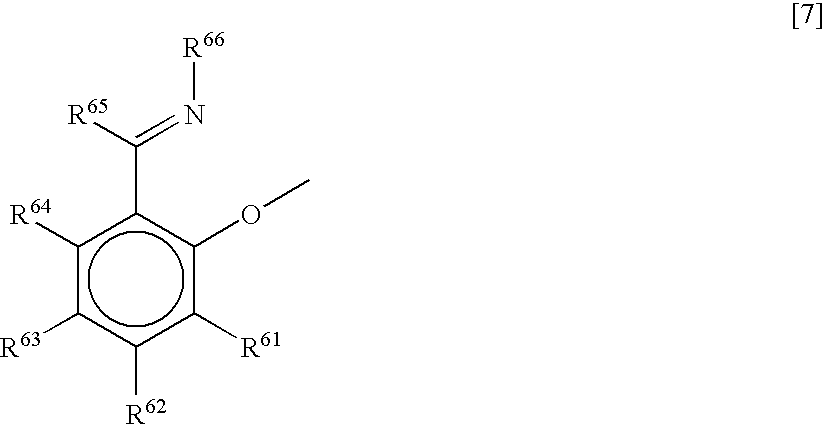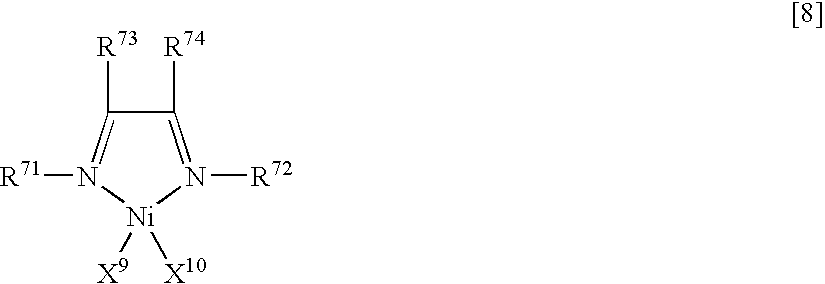Contact product, and catalyst component and catalyst for addition polymerization, and process for producing addition polymer
a technology of catalyst components and catalysts, applied in the direction of catalyst activation/preparation, physical/chemical process catalysts, chemical/physical processes, etc., can solve the problems of unsatisfactory polymerization activity, and achieve the effect of excellent polymerization activity
- Summary
- Abstract
- Description
- Claims
- Application Information
AI Technical Summary
Benefits of technology
Problems solved by technology
Method used
Image
Examples
example 1
(1) Preparation of Contact Product
[0248]Into a 100 ml four-necked flask purged with argon, 40 ml of toluene and 1 ml of a hexane solution of ZnEt2 (concentration of ZnEt2: 2.02 M) were added. Thereto, 0.292 ml of a toluene solution of pentafluorophenol (concentration of pentafluorophenol: 2.77 M) was added dropwise at room temperature. Thereafter, 29.1 μl (1.615 mmol) of water was added dropwise with a microsyringe at room temperature. After completion thereof, the mixture was stirred at 70° C. for one hour. The reaction mixture was a yellow slurry. Thereto, 116.3 mg (0.217 mmol) of methyldioctadecylamine and 10 ml of toluene were aded. The mixture was stirred at 70° C. for one hour, thereby obtaining a yellow slurry (hereinafter, referred to as “slurry ①”). A concentration of Zn contained in the slurry ① was calculated to be 40 μmol-Zn / ml,
(2) Polymerization
[0249]After drying under vacuum an autoclave reactor having an inner volume of 400 ml equipped with a stirrer, and replacing th...
example 2
(1) Preparation of Contact Product
[0250]Example 1 (1) was repeated except that the added amount of methyldioctadecylamine was changed to 224.6 mg (0.419 mmol). As a result, there was obtained a yellow slurry (hereinafter, referred to as “slurry ②”). A concentration of Zn contained in the slurry ② was calculated to be 40 μmol-Zn / ml.
(2) Polymerization
[0251]Example 1 (2) was repeated except that the slurry ① was changed to the slurry ②. As a result, 4.04 g of an ethylene-1-hxene copolymer was obtained. The polymerization activity, SCB, Mw and Mw / Mn were 1.8×108 g / mol-Zr / hour, 10.2, 71000 and 2.0, respectively.
example 3
(1) Preparation of Contact Product
[0252]Example 1 (1) was repeated except that the added amount of water and the added amount of methyldioctadecylamine were changed to 32.8 μl (1.82 mmol) and 226.1 mg (0.422 mmol), respectively. There was obtained a yellow slurry (hereinafter, referred to as “slurry ③”). A concentration of Zn contained in the slurry ③ was calculated to be 40 μmol-Zn / ml.
(2) Polymerization
[0253]Example 1 (2) was repeated except that the slurry ① was changed to the slurry ③. As a result, 6.04 g of an ethylene-1-hxene copolymer was obtained. The polymerization activity was 2.4×108 g / mol-Zr / hour.
PUM
| Property | Measurement | Unit |
|---|---|---|
| Substance count | aaaaa | aaaaa |
Abstract
Description
Claims
Application Information
 Login to View More
Login to View More - R&D
- Intellectual Property
- Life Sciences
- Materials
- Tech Scout
- Unparalleled Data Quality
- Higher Quality Content
- 60% Fewer Hallucinations
Browse by: Latest US Patents, China's latest patents, Technical Efficacy Thesaurus, Application Domain, Technology Topic, Popular Technical Reports.
© 2025 PatSnap. All rights reserved.Legal|Privacy policy|Modern Slavery Act Transparency Statement|Sitemap|About US| Contact US: help@patsnap.com



